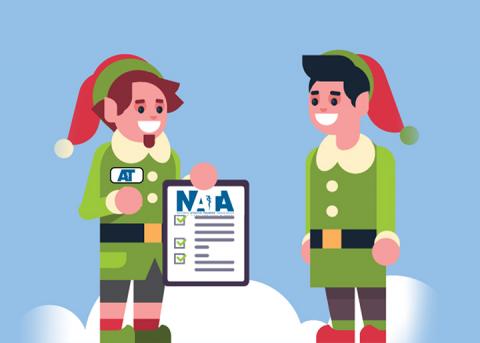
Five Things Santa and His Elves Have to Do to Avoid Christmas Disaster
Dear Santa,
As you and the elves at the North Pole prepare for your busiest and biggest night of the year, we know that you and your team will face challenges including extreme weather, dangerous and slippery rooftops, hauling heavy packages and maneuvering down a wide variety of chimneys. These working conditions put you and the elves at risk for concussions, sprains, overuse and cold weather injuries, and much more.
Millions of people around the world are counting on you, and as athletic trainers (ATs) who specialize in injury prevention, diagnoses and rehabilitation, we want to share a few tips on ways to reduce the risk of injury to you and your team during the holiday.
1) Get warmed up. While Christmas cheer may warm up your heart, it won’t help warm up muscles, which is key in preventing injury. Get your muscles and body ready with a dynamic movement warm-up that mimics the work you will be doing. It also helps get the blood pumping and muscles stretched and ready-to-go.
2) Be ready for the weather. While it’s very cold in the North Pole, places like Australia are hot this time of year. That means that layers are key in maintaining a safe body temperature to avoid heat illness and cold injury. If things get a little sweaty or wet during your travels, we recommend having at minimum a second suit to change into as moisture will result in cooler body temperatures which increase the risk of cold injuries such as hypothermia when traveling in wintery conditions.
3) Stay hydrated. Hot chocolate, cider and eggnog are delicious but aren’t very hydrating. Drink water and sports drinks to avoid dehydration symptoms such as fatigue, muscle cramps, and dizziness. It’s also key in maintaining a safe body temperature. This is especially important in cold climates where many people don’t realize the critical need to properly hydrate.
4) Get evaluated. Making one toy usually doesn’t take a toll on the body, but making millions of toys opens elves up to risks of overuse injuries from repetitive movements. This can be prevented by having the elves and the motions they perform evaluated by a sports medicine professional such as an athletic trainer to make sure that body movements are done correctly and safely.
5) Communicate. No matter how time-crunched you are, it’s much better to take a little time to correct or address muscle discomfort when it starts than it is to treat an injury once it has occurred. Ideally, you should have an athletic trainer with you at the workshop and in the sleigh to help identify, prevent and treat injuries if they occur.
Athletic trainers usually bring visions of football fields instead of sugar plum fairies, but many of us are employed to help active individuals such as production workers, military personnel, dancers, and others work at their physical best by making sure injuries are prevented and addressed quickly and safely.
We would also like to share that many progressive companies – with a similar business structure that includes product fulfillment, loading and deliveries – hire athletic trainers to improve safety measures and the overall efficiency of their operation. With ATs throughout your supply and distribution chain, you will be on the forefront of injury prevention, which will help ensure safe and happy elves – and very happy customers.
We hope these tips help you and the North Pole team have a jolly and safe Christmas.
- National Athletic Trainers’ Association





